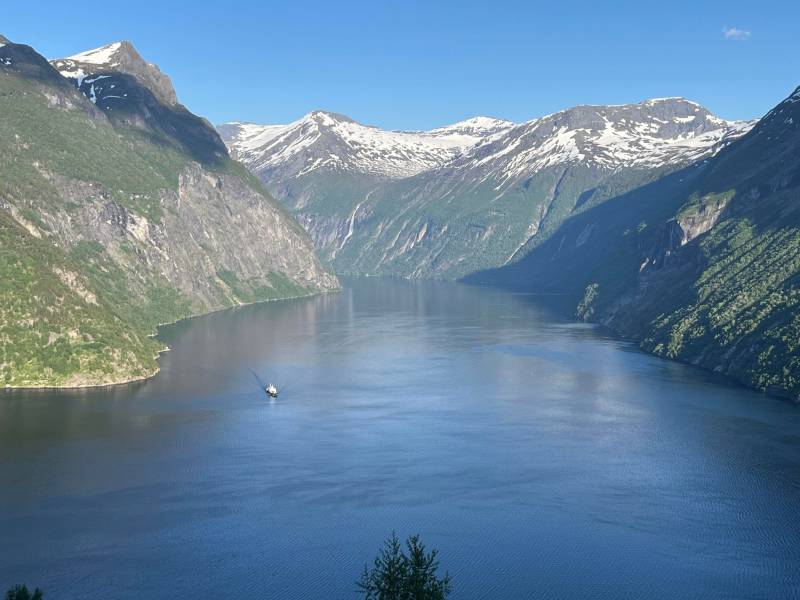
A wonderful ferryride on the Geiranger fjord
Provided by:
Vestlandske AS

Press "DOWNLOAD" and "START" to open the map. The stories start automatically when we pass the various places as long as it is not in sleep mode, and you can still use the phone for pictures, calls, etc.
Points of interest
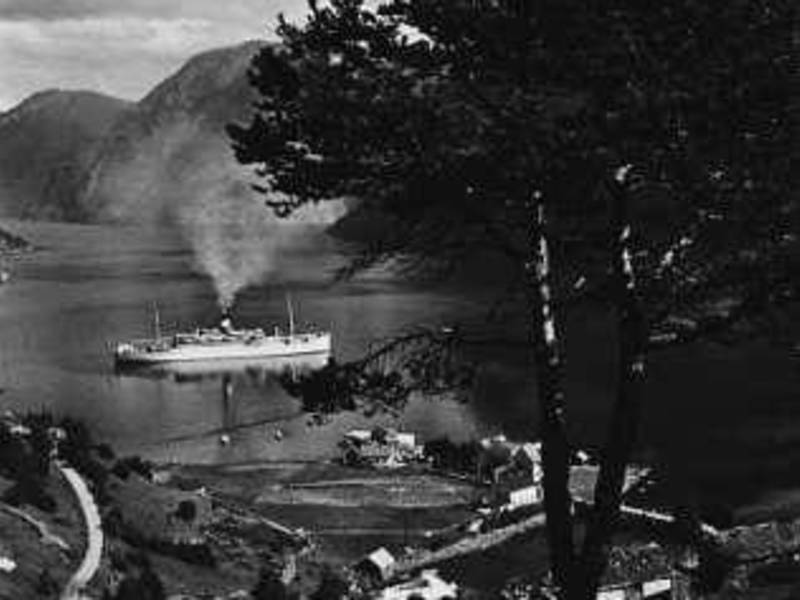


#1
Hellesylt
Dear guests! We are now moving into the area around Hellesylt. A charming little town at the heart of the Sunnylvsfjorden – an arm of the famous Geirangerfjord. Surrounded by majestic mountains, thundering waterfalls and lush nature, Hellesylt is a perfect starting point for exploring the UNESCO-protected fjord landscape. Hellesylt offers cozy cafes, local crafts and a beautiful church from 1859. Right by the ferry dock you will find Hellesyltfossen, a spectacular waterfall that flows right through the city center – a popular photo opportunity and a natural gathering point. In the summer, cultural festivals and concerts are held, and you can also take hiking tours in the mountains, go kayaking or visit the renowned wool manufacturer Devold's outlet, if you need to dress for the Norwegian summer weather! For those interested in history, Hellesylt is a hub for stories about both the Viking Age and recent Norwegian history. In this landscape you will find, among other things, the "Trondhjem Post Road", which has long carried people between Bergen and Trondheim. Whether you start or end your ferry trip here, Hellesylt is well worth a visit!
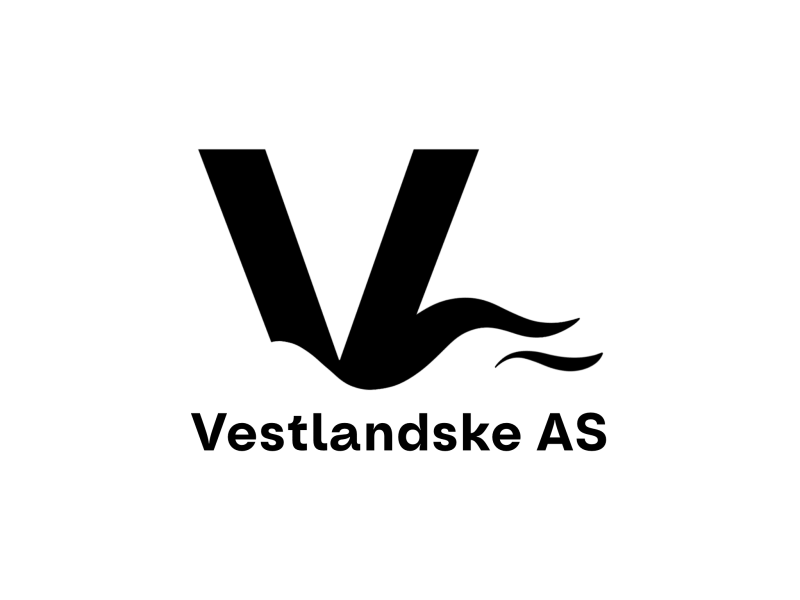
#2
Boarding and disembarking Hellesylt
You are now sailing by ferry from Vestlandske between Hellesylt and Geiranger. The crossing takes one hour and fifteen minutes. We would like to ask you to pay attention to the safety rules and the smoking ban on board. Also pay attention to the signs that show the way to the exits, life belts and the raft stations. In the event of an emergency, please listen to the information over the loudspeakers and follow the instructions given by the crew. The best view of the attraction along the Geirangerfjord is up on the sun deck, or in the lounge. In the cafeteria in the lounge you can buy coffee, tea, mineral water, sandwiches, cakes and hot dishes. If you want to take a Norwegian souvenir home with you, we recommend a visit to the cafe. Here you will find, among other things, the book Trolls and Magic – one of the most popular collections of Norwegian folk tales, based on the stories of Asbjørnsen and Moe. The book is richly illustrated and available in several languages – a perfect gift or a memorable insight into Norwegian fairy tale tradition. Explore and learn more about the nature, culture and history around you by downloading the guiding app Guide to Go on your mobile phone. You will find a QR code and instructions on board. Need help? Feel free to ask one of our crew members – we will be happy to help you get started! We wish you a memorable and enjoyable trip with us through the magical fjord landscape!
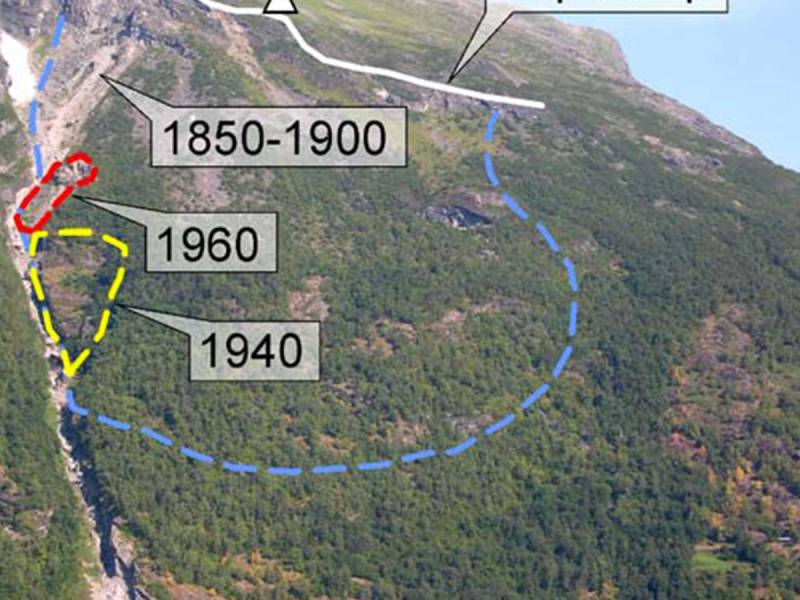
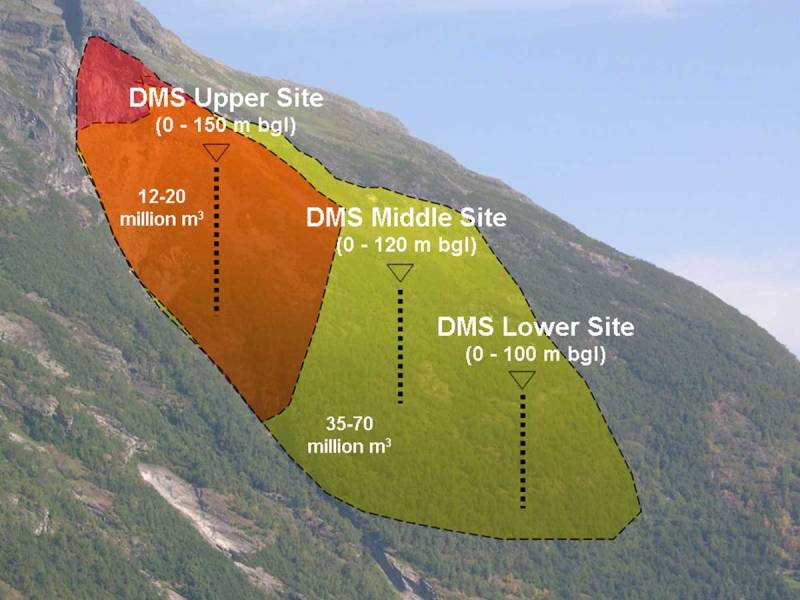
#3
Åkernes-remna
You are now in the Sunnylvsfjorden, and we are now moving in an area close to Åkernes-remna. A continuously growing crack in the mountain wall above Åkerneset near Sunnylvsfjorden increases the risk of a large rock mass collapsing. It is expected that the volume of the landslide will create a dramatic tsunami and obliterate life along the fjord. In 2015, the movie "The Wave" depicted the extent of the natural disaster that would cost communities around the Geirangerfjorden. Ragnhild Åkernes feared for her own life in 1920 when she witnessed a rockfall from the remna plowing through the Meåknes farm located on the mountainside. She was standing in the middle of the courtyard when she suddenly heard a deep, rumbling sound followed by a cloud of earth, sand, and dust rising up. The rockfall smashed the summer barn, while she herself escaped with her life. Today, the rock crack is 25 meters wide and 600 meters deep. It is expected that more than 50 million cubic meters will collapse. The remna is continuously monitored by geologists, and evacuation plans have been prepared.
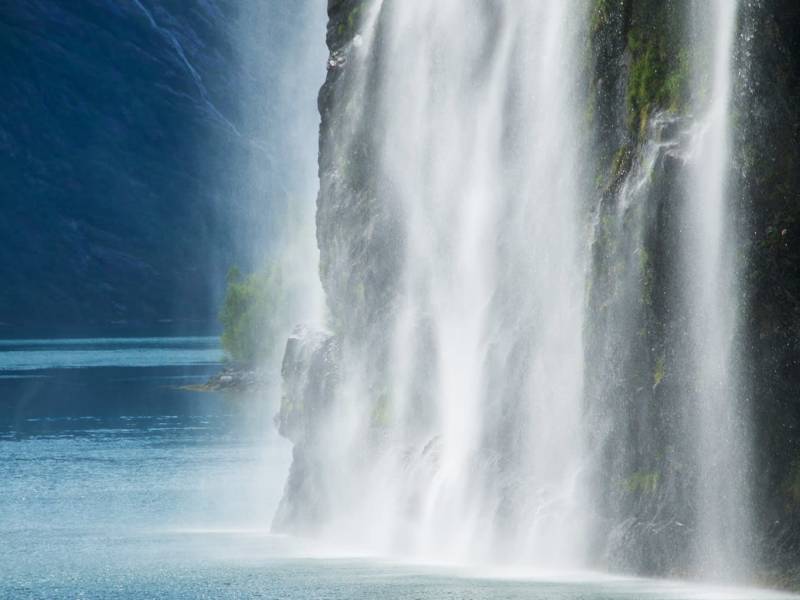


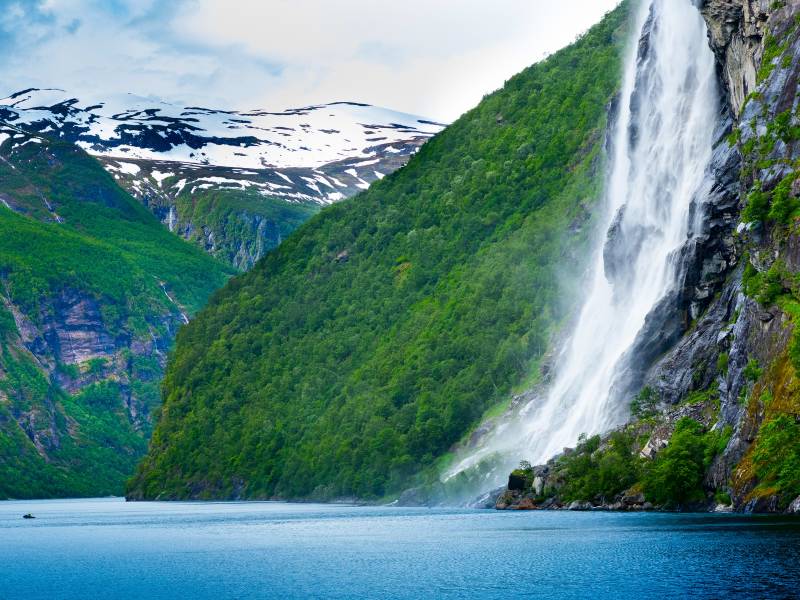



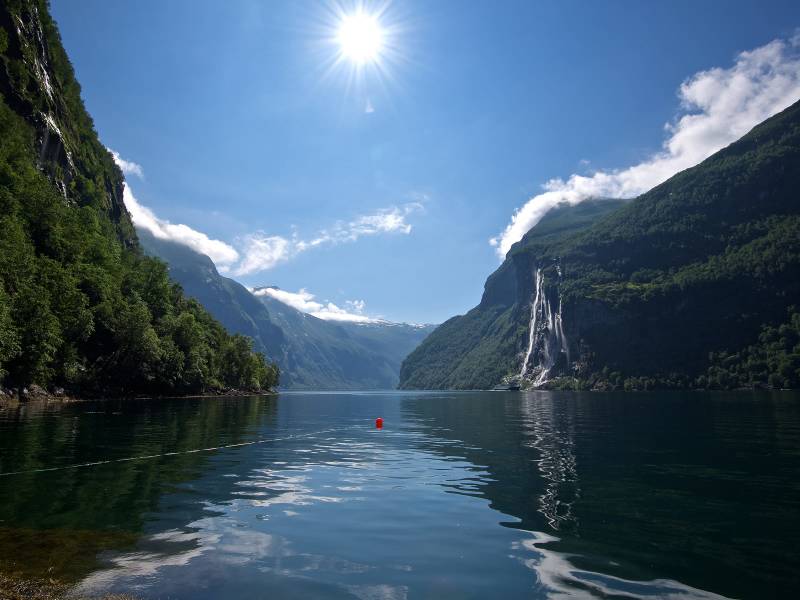
#4
Geirangerfjorden
You are now sailing in the beautiful Geirangerfjord. The fjord is 200 meters deep, and the mountains on each side rise to well over 1000 meters. The sea route through this spectacular scenery offers a moment of national romanticism. The journey along the fjord hasn't always been like this. In the past, the fjord was the only route to civilization. On cold days, the fjord could freeze over. When the boat couldn't progress, people had to walk on the ice, as long as it held. If someone fell ill or needed help, the fjord could be a significant obstacle to people's safety. Once, when the children from "Litleseter" were in the boat crossing the fjord on their way to school, a rock crashed through the boat. The rock hit right between the children's legs and caused large amounts of water to fill the boat. The man plugged the hole with peat and continued to row while the children bailed water for their lives. Fortunately, they survived, and the school day continued as usual. Can you imagine how scared they must have been from the experience?

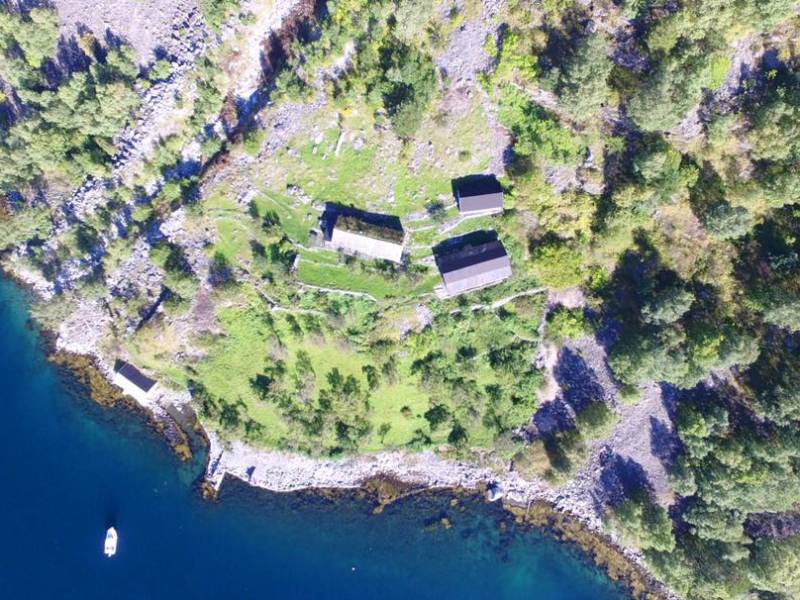
#5
Matvika
We are now passing Matvik farm. Matvik rightly carries its name. Until the last residents left the farm in 1961, the place contributed to particularly good yields of fruits such as apples, pears, and plums. Much of the credit for the good harvest goes to the farm's location. Situated in a sunny spot, shielded from the Norwegian "north wind," the warm air thrives here and has created favorable growing conditions for years. One year, it was recorded that the farm produced 60 kilos of apricots, which is not typical for the Norwegian climate. The Storfjordens venner association has invested millions and countless hours of work to preserve the remaining buildings. Isn't it beautiful?


#6
Gomsdalen
Imagine a farm high up in the mountains, deep in the valley, and there you'll find Gomsdalen. The place is situated on the north side of the Geirangerfjord at an altitude of 600 meters. If you haven't heard of this place yet, it's worth noting. People have been living here since the Stone Age, and tales from this remote valley testify to a life marked by adversity and hardship. One woman who left her mark is Kristianne Helsteinsdotter. She was a midwife like no other. Stories tell of her trekking three kilometers on a winter night to attend to her midwifery duties, and that at the age of 77. With a lantern and staff in hand, and a good dose of determination, she braved the weather, wind, and a rockslide terrain to assist a woman in labor. The joy was immense when she arrived and saw the baby safely cradled in the mother's arms. She herself had tragically lost both her husband and several children. Life's wisdom had taught her that hard work was the best remedy for grief and toil. Perhaps that's why she was willing to risk her own life to help others?

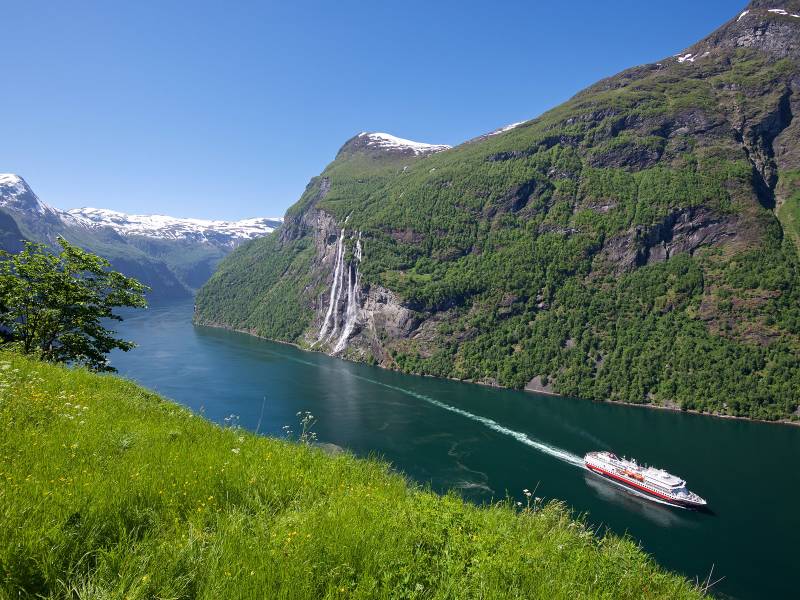


#7
Mountain shelves farms
You can now catch sight of the idyllic mountain farms 250 meters above the fjord. Solitary, yet beautifully perched on their respective mountain shelves. Surrounded by waterfalls and forests, these abandoned farms have become a popular landmark for tourists and mountain enthusiasts worldwide. This is truly a gem out of the ordinary. For the people who lived here, life was a struggle for survival. Challenges and hardships were commonplace, and nothing came for free. The people were naturally self-sufficient, and life demanded long and hard workdays to make ends meet. Meals were a gathering point for the people, and over the years, everything from fish, bread, milk, butter, pancakes, cakes, and coffee was served. While the adults worked, the children were secured with ropes to prevent them from wandering off the cliffs. Zip lines were also used to transport goods from the fjord up to the farmstead. Today, the knowledge of life on these farms is recorded in books and visualized in pictures. Sakarias Ansok is a name to remember. He was forward-thinking when he decided to travel around and record stories from the people along the fjord. The mountain farms are some of the most beautiful aspects of Norwegian culture.

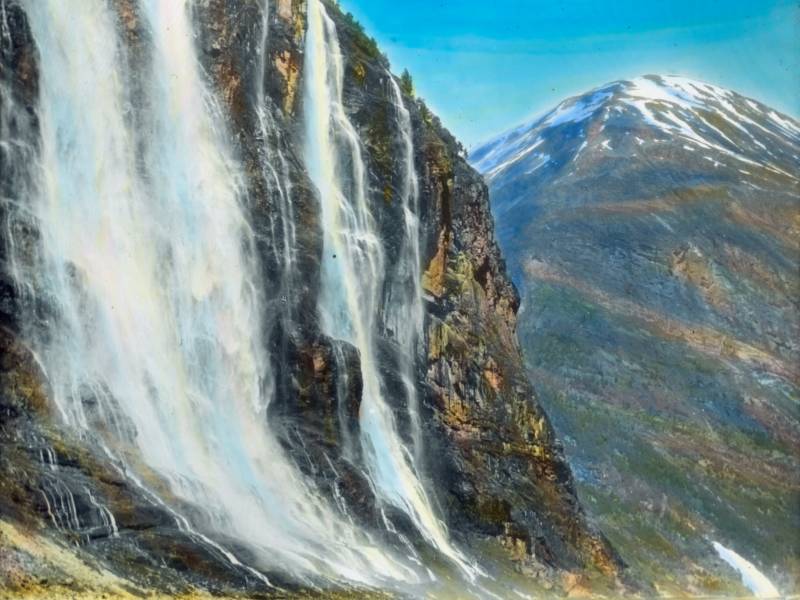

#8
The Seven sisters
In the Geirangerfjord, you will find the well-known waterfall "The Seven Sisters." If you look out, you can now enjoy the sight of this beautiful waterfall up close. Here, you truly get to experience the forces of nature. With a free fall of over 250 meters, it plunges straight into the fjord. The strength of the waterfall varies with precipitation and season, being strongest as the melting of snow in the mountains begins. According to an old legend, the seven sisters are unmarried. The waterfall on the opposite side of the fjord has therefore naturally been named "The Suitor." In the middle of this waterfall, you can see the contours of what resembles a bottle. The legend tells that the suitor, after constantly being rejected by the sisters, sought solace in the bottle.
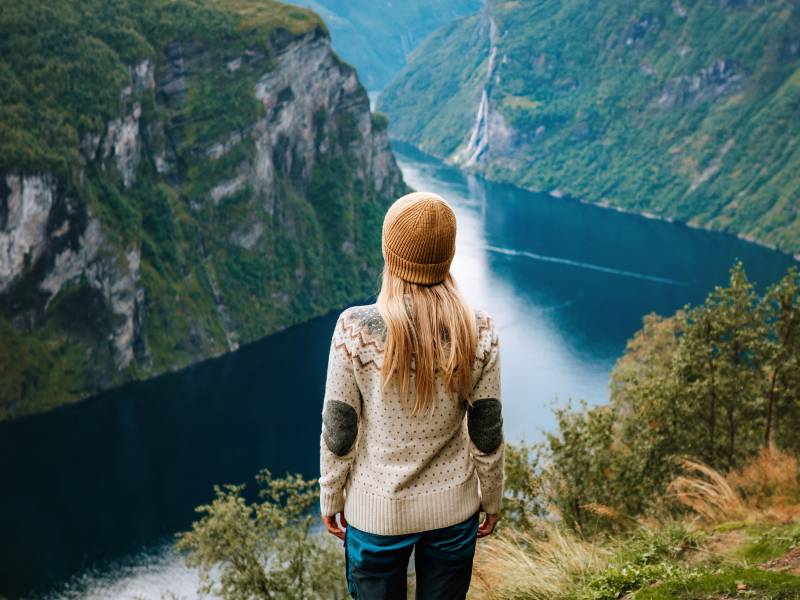
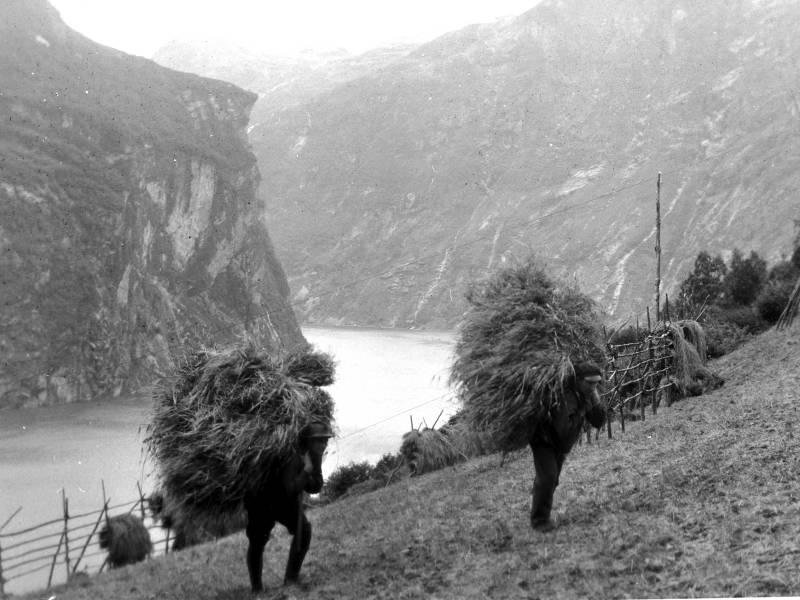


#9
Knivsflå
Right next to the waterfall "The Seven Sisters," lies the farm Knivsflå, also called the knife, perched on a mountain shelf. If you look up the mountainside, you can now catch sight of the roadless farm. At Knivsflå, the fjord was the only route to civilization. And as long as the people here weren't weatherbound, the children were transported to and from school by rowboat, in the old days. To get to the sea, they first had to climb down along the mountainside. With no handrails to hold onto or steps to climb, the path was perilous. For these people, it was entirely normal to have to balance on a mountain shelf over a precipice to get ahead. Perhaps this made the people at "The Knife" something out of the ordinary? The legend Ole Knivsflå, also known as "Big Knife," was the heir and last generation of permanent residents at Knivsflå. At the age of 13, the family moved from the mountain farm, but he never stopped practicing what he had learned from life at Knivsflå. As a hunter, he shot two wolverines with one shot, and every day he came home with 30 ptarmigans in his hands. And if danger was looming, "Big Knife" was summoned, like the community's own superhero. Today, Knivsflå is a popular hiking destination. If you wish, you can take a guided tour back and forth to the mountain farm with a fjord safari. Doesn't that sound like a great experience?





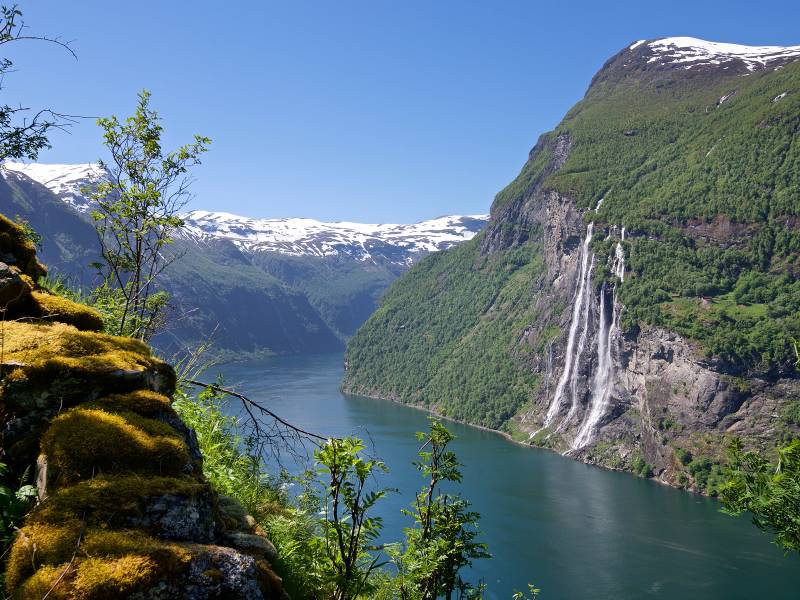
#10
Skagaflå
As you can probably see, we are now sailing right below the world-famous farm Skagaflå. The farm is among the most famous and visited mountain farms along the Geirangerfjord. The Norwegian king and queen celebrated their silver wedding anniversary at this beautiful location, with guests from large parts of Europe attending. Due to the challenging terrain, the Norwegian and Swedish kings arrived at the farm by helicopter. At the beautiful mountain farm Skagaflå, the forces of nature wreaked havoc around the walls of the houses in all seasons. Like on a winter day in 1873 when it rained heavily. Water flowed in large streams, turning the ground into mud. In the evening, it all ended with a large landslide rushing towards the houses at Skagaflå. The family living there became scared and ran for their lives towards a narrow ledge below the cliff edge. On the way to the cliff, the head of the household slipped with the youngest child in his arms, causing the boy to hit his head on a rock. Soaked and frozen stiff, they clung to the ledge throughout the night, with no certainty that the child was alive. The joy was immense when the son showed signs of life in the morning, and to top it off, they saw that the house was still standing on the courtyard. The villagers can recount many stories similar to this one. Over the past hundred years, landslides have claimed six lives. Could you imagine living here?
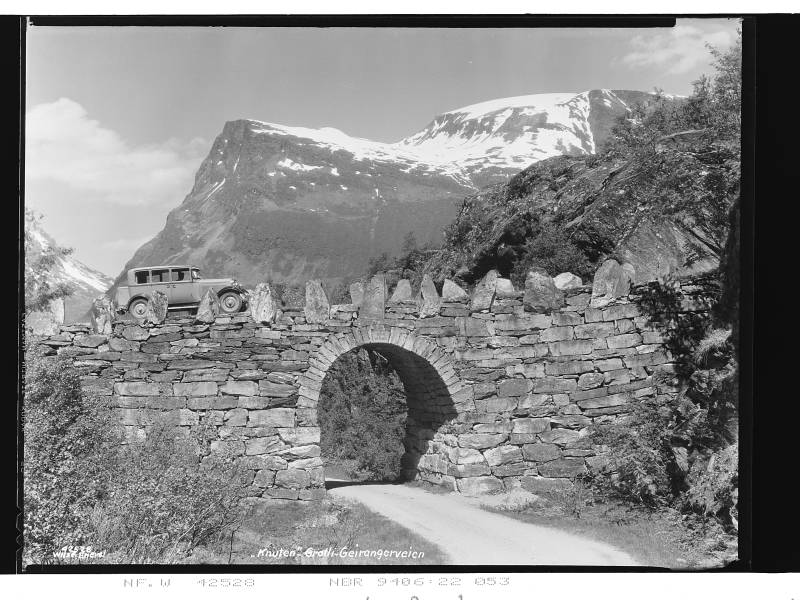
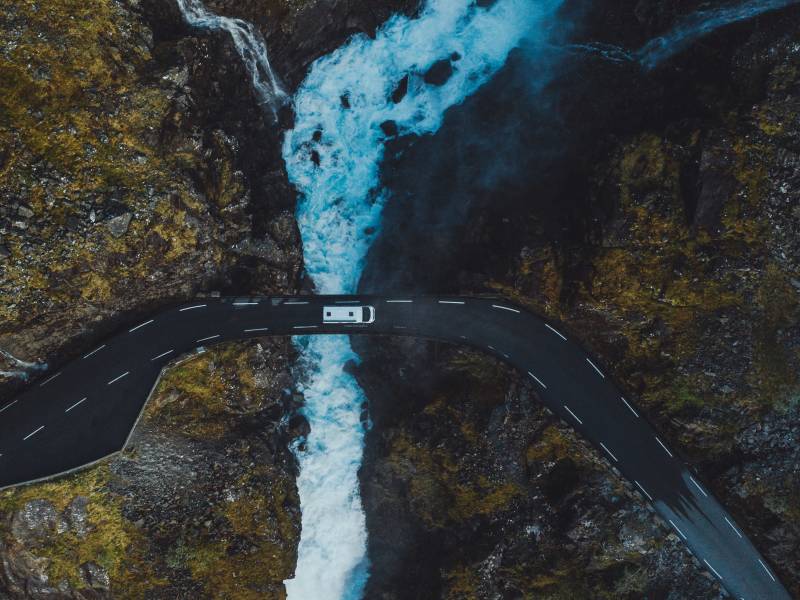


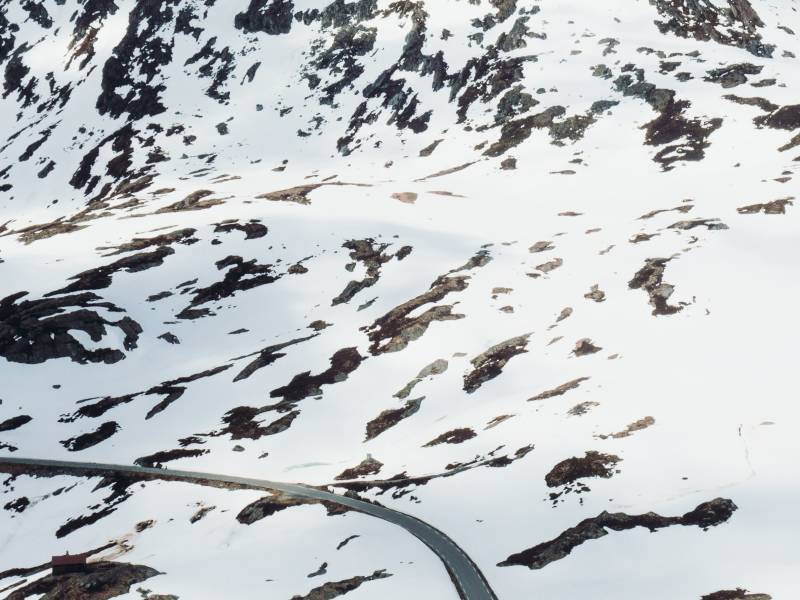
#11
A road towards the world
As early as 1881, work began on building the first road to Geiranger. The mountain pass created a connection between Sunnmøre and Romsdalen. Before that time, the fjord was the gateway to the outside world, and beautiful Geiranger was a well-preserved gem. Along the 38-kilometer road stretch from Geiranger to Grotli, you'll find 29 large bends, 9 beautiful stone arch bridges, and 5364 curb stones to prevent vehicles from ending up in the ditch. In a short drive up to Dalsnibba, you've ascended 1500 meters above sea level. There, you can enjoy the view without burning a single calorie. The trip is considered Geiranger's greatest attraction. From Dalsnibba, the road continues over the mountain and down the famous Trollstigen, with its final destination in Åndalsnes. The road is described as an architectural marvel. Among the people who first used the road with horse and carriage, enthusiasm wasn't as high. It's been said that a farm woman used to chase the tourists off the carriage uphill, while she herself sat on the coachman's seat. The road turned out to not only create transportation but also open the door to tourism. One day, Karl Mjelva had the industrialist Adam Opel as a guest at his hotel. During the stay, the two had entered into a partnership agreement to produce cars specifically designed for the roads in Geiranger. This meeting marked the beginning of a new era. The car not only streamlined transportation but also tourism. The driver would now navigate the car and act as a guide in multiple languages simultaneously.

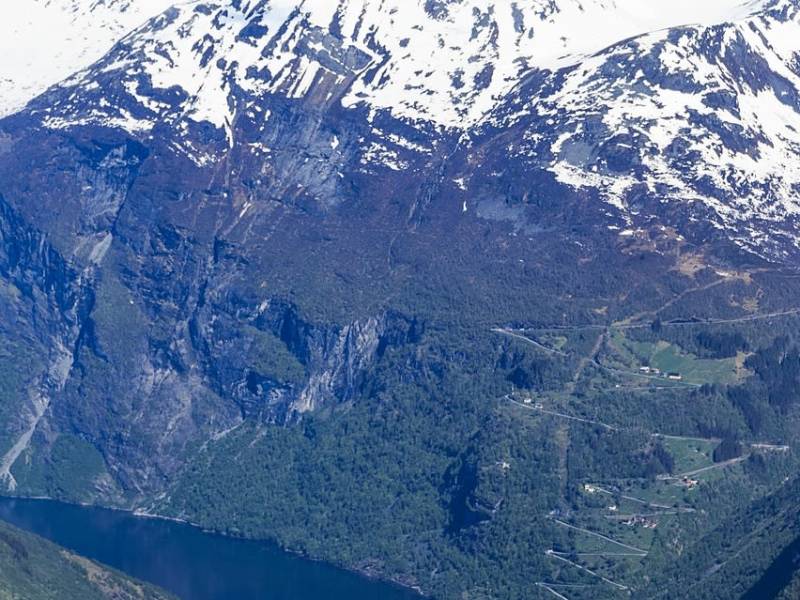
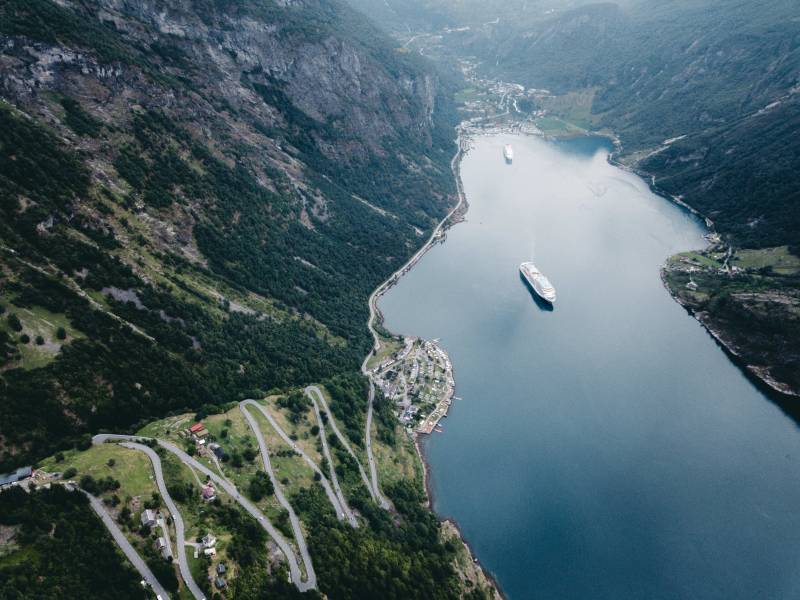

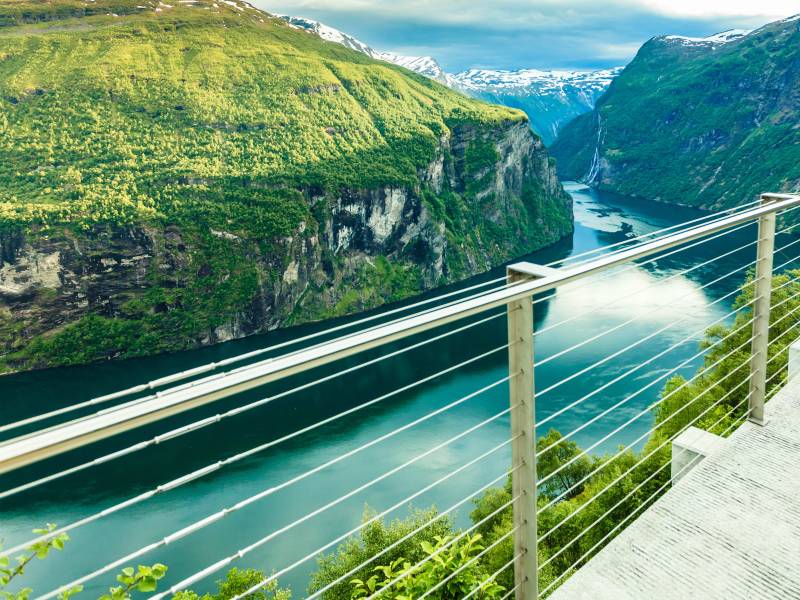
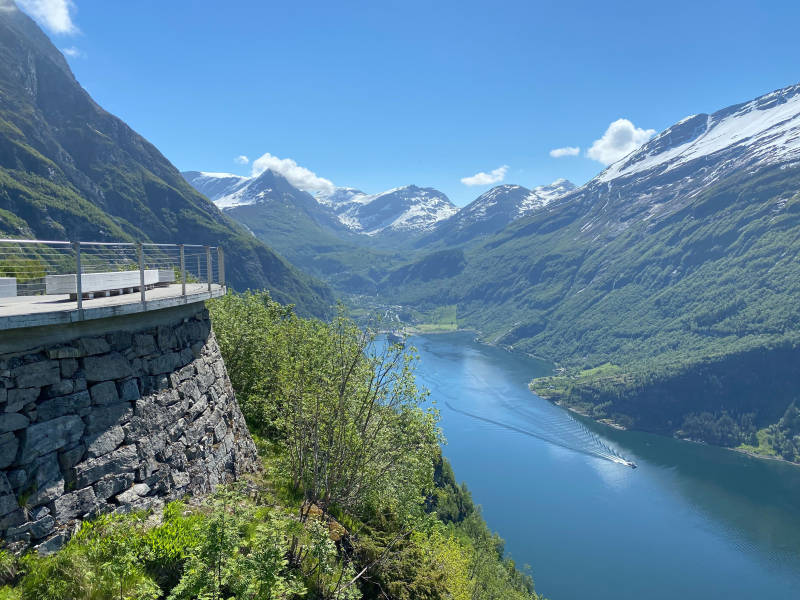

#12
Ørnesvingen
Dear guests! You will now be able to see the famous landmark Ørnesvingen. The need for a road to Sunnmøre was great, and the joy even greater when the connection between Geiranger and Eidsdal was established in 1955. Ørnevegen, or the Eagle Road as it is also called, got its name because the road was built in an area with many eagles. The Norwegian seasons have a significant impact on the road. The descent with its sharp turns often leads to the road being closed in the winter. With its 11 turns down the steep mountain, you can stand at the viewpoint, 620 meters above sea level, and enjoy the view over Geiranger, the Geirangerfjord, the waterfall "The Seven Sisters," and the mountain farm Knivsflå. Definitely worth a visit.


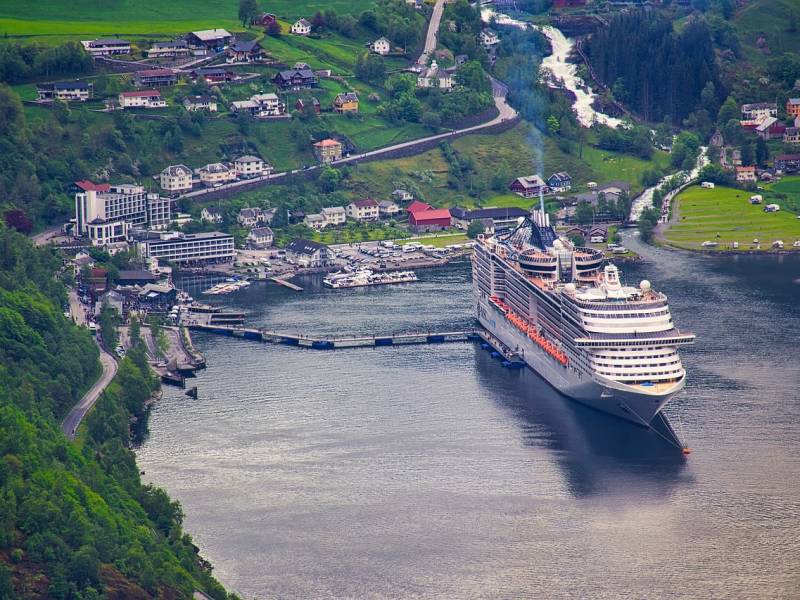

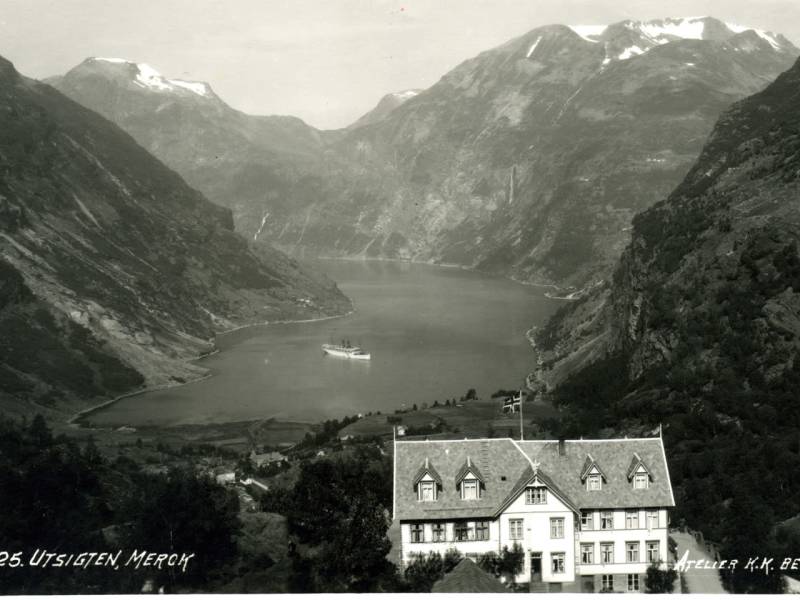

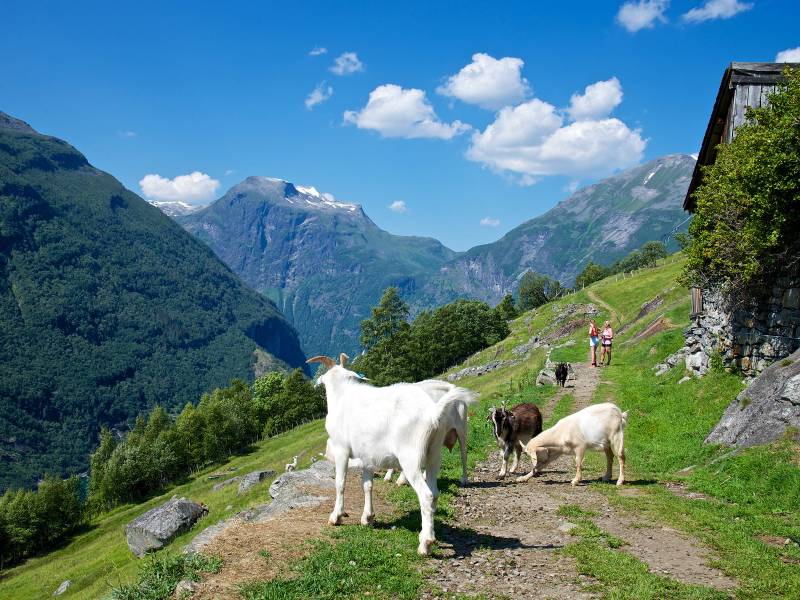

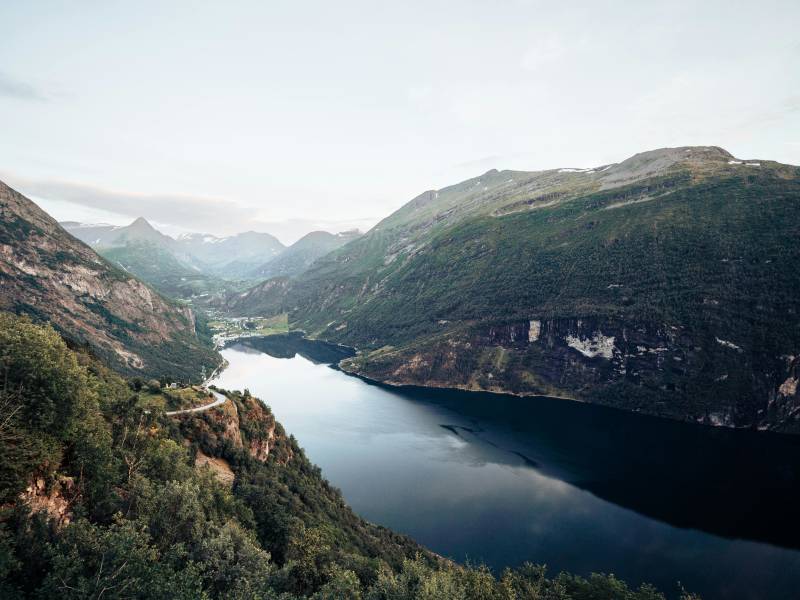
#13
Geiranger
We can now see the innermost part of the fjord, where the small place Geiranger is located. Geiranger is a stop for this tour and can be considered an exceptional village. The forces of nature dominate the people here, and they know to respect these boundaries. When winter rages at its worst, it's as if the whole village freezes over. It's no wonder Disney was inspired to create the movie "Frozen" from this place. After a long and quiet winter, Geiranger almost transforms into a big city. With 360,000 cruise passengers on over 300 visiting cruise ships each year, this place can be considered one of the country's most visited tourist destinations. Two out of three inhabitants in Geiranger make their living from tourism. A stay at the Union Hotel, among other things, is considered a popular holiday destination. The hotel was built in 1891 with a facade in Swiss architecture and stands adorned by the splendor of the Storfossen waterfall that cascades around the beautiful building. In the years before Geiranger became a tourist destination for kings, celebrities, and the general public, the center of Geiranger, Maråk, served as a marketplace for farmers, fishermen, and hunters. The center can still be considered the hub for shopping today. In the summer, the streets fill with souvenir shops, local food, and cafes, and a walk along the waterfront is a must-experience.
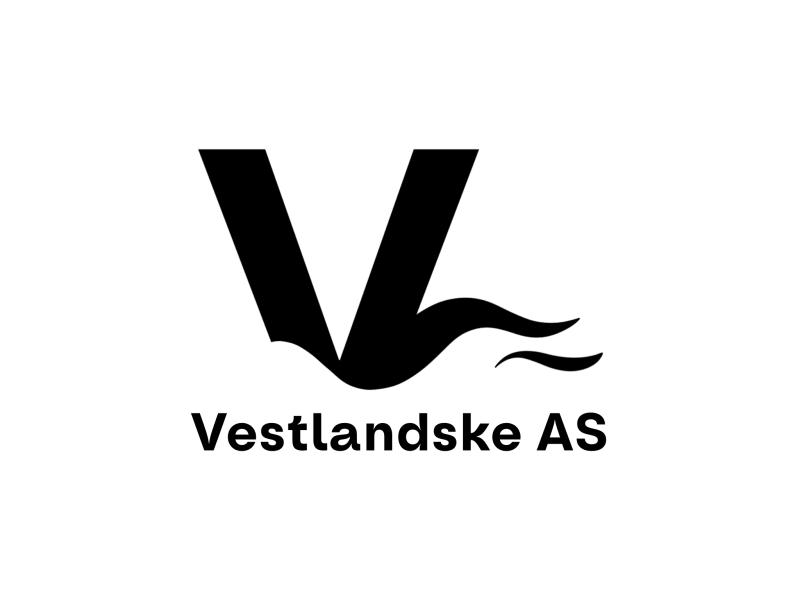
#14
Boarding and disembarking Geiranger
You are now sailing by ferry from Vestlandske between Geiranger and Hellesylt. The crossing takes one hour and fifteen minutes. We would like to ask you to pay attention to the safety rules and the smoking ban on board. Also pay attention to the signs that show the way to the exits, life belts and the raft stations. In the event of an emergency, we ask you to listen to the information over the loudspeakers and follow the instructions given by the crew. The best view of the attraction along the Geirangerfjord is up on the sun deck, or in the lounge. In the cafeteria in the lounge you can buy coffee, tea, mineral water, sandwiches, cakes and hot dishes. If you want to take a Norwegian souvenir home with you, we recommend a visit to the cafe. Here you will find, among other things, the book Trolls and Magic – one of the most popular collections of Norwegian folk tales, based on the stories of Asbjørnsen and Moe. The book is richly illustrated and available in several languages – a perfect gift or a memorable insight into Norwegian fairy tale tradition. Explore and learn more about the nature, culture and history around you by downloading the guiding app Guide to Go on your mobile. You will find a QR code and instructions on board. Need help? Feel free to ask one of our crew members – we will be happy to help you get started! We hope you have a great experience in the spectacular fjord landscape. We wish you a good trip!